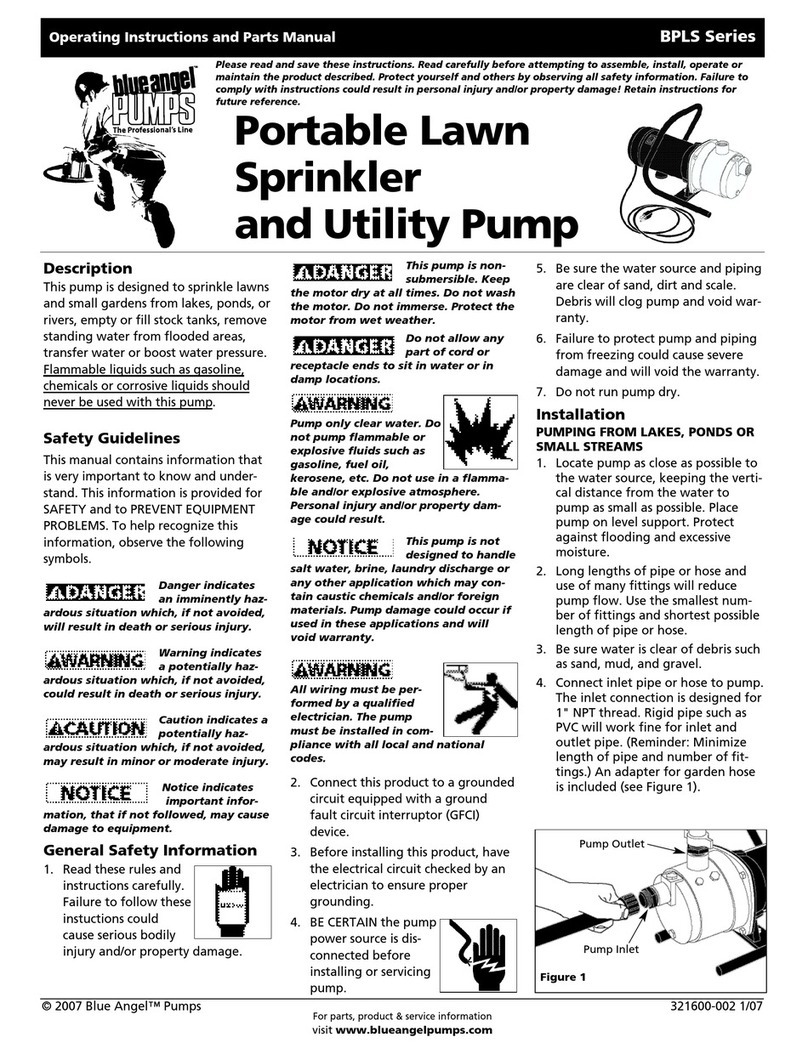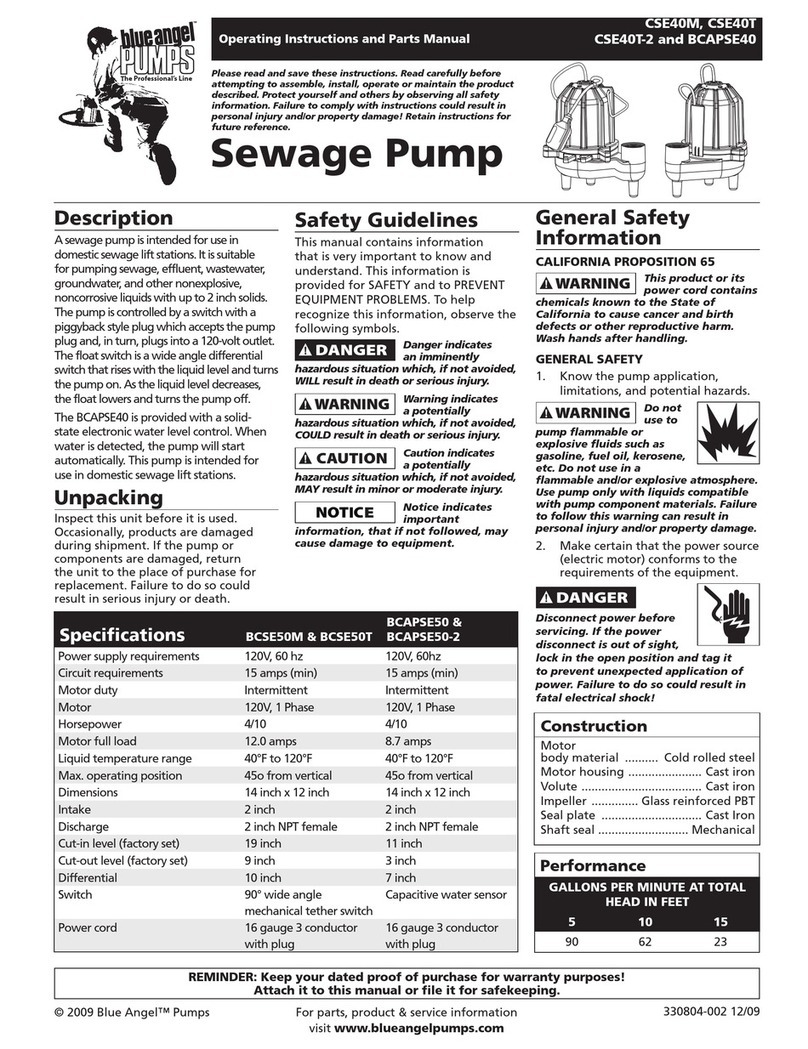
Instructions d‘Utilisation et Manual de Pièces
8 Fr
2. S’assurer que la source de courant
(moteur électrique) se conforme
aux exigences de l’équipement.
Débrancher la source
de puissance avant de
procéder au service. Si la
source d’alimentation est hors vue, la
verrouiller dans la position ouverte et
l’étiquetter afin d’éviter une application
de puissance inattendue. Manque de
suivre ces directives peut résulter en
secousse électrique!
3. Dissiper toute la pression dans
le système avant de procéder au
service de n’importe quelle pièce
détachée.
4. Purger tous liquides du système
avant de procéder au service.
Cette pompe contient
de l’huile à moteur
diélectrique pour le transfert de chaleur du
moteur. Attention en éliminant cette huile.
Ne pas utiliser cette pompe dans les étangs
ou les fontaines car l’huile à moteur pourrait
être dangereux pour la vie aquatique.
5. Fixer la ligne de décharge avant de
démarrer la pompe. Une ligne de
décharge non-fixée peut fouetter et
causer des blessures personnelles et/
ou des dégâts matériels.
6. Inspecter les tuyaux pour la faiblesse
et l’usure avant chaque utilisation
et vérifier le serrage de tous les
branchements.
7. Inspecter la pompe et les
pièces détachées du système
périodiquement. Exécuter l’entretien
ordinaire (Se référer à la section
d’Entretien).
8. Fournir un système de soulagement
de pression pour les pompes avec
lignes de décharge qui peuvent
devenir obstruées ou coupées.
9. Sécurité Personnelle:
a. Toujours porter des lunettes de
sécurité si vous travaillez avec les
pompes.
b. Garder l’endroit de travail propre,
non-encombré et bien illuminé.
Ranger tous outils et équipement
après l’usage.
c. Garder les visiteurs à une distance
sûre de l’endroit de travail. Protéger
l’atelier pour les enfants avec des
cadenas, interrupteurs principals et
en enlevant les clefs de démarrage.
10. Pendant l’installation de fils d’une
pompe électrique telle que celle-ci,
suivre tous les codes de sécurité ainsi
que les codes récents du National
Electrical Code (NEC) et l’ Occupation-
al Safety and Health Act (OSHA).
Risque
de secousse électrique! Ne
jamais brancher le fil vert
(ou vert et jaune) à une
borne électrisée!
11. Cet équipement est conçu pour un
circuit de 120 v (monophasé) et est
équipé d’un cordon approuvé à trois
conducteurs et une fiche de terre à
trois broches telle qu’indiquée dans
la Figure 1A et 1B.
Pour réduire le risque de secousse
électrique, le moteur doit être mis à la terre
correctement et avec sûreté comme suit:
• Introduirelafichedirectementdans
une prise de terre tripolaire, installée
correctement et mise à la terre (tel
qu’indiquée dans la Figure 1).
• Compléteruneinstallationdefils
permanante avec un système de
canalisation en métal mis à la terre.
• Autresmoyensacceptables.
Remplacer les prises à deux broches
avec des prises à trois broches mises à
la terre correctement selon les codes et
ordonnances locaux et de NEC.
12. Toute installation de fils doit être
performée par un électricien qualifié.
13. Il est recommandé que le modèle
soit branché dans un disjoncteur de
fuite à la terre (DDFT). Consulter un
électricien local pour la disponibilité
et l’installation.
Le moteur de
la pompe est
équipé d’un protecteur thermique à
réenclenchement automatique et peut
se mettre en marche subitement. Le
déclenchement du protecteur est une
indication de surcharge du moteur
résultant du fonctionnement de la pompe
à basse pression (restriction de décharge
basse), tension extrèmement élevée ou
basse, installation de fils insuffisante,
conditions de moteur incorrectes, ou un
moteur ou une pompe défectueux.
14. Cette pompe est conçue pour
transporter l’eau en cycles.
Utiliser cette pompe dans une
application continue en manipulant
l’interrupteur pour qu’il reste
enclenché affectera la performance
et l’espérance de vie du produit.
15. Protéger le cordon d’alimentation des
objets pointus, surfaces chaudes, huile
et produits chimiques. Ne pas tortiller
le cordon. Remplacer ou réparer
les cordons usés ou endommagés
immédiatement. Utiliser des fils de
taille suffisante pour minimiser la
chute de tension au moteur.
16. Ne pas manipuler une pompe ou une
pompe de moteur avec les mains
trempes ni lorsque vous êtes debouts
sur une surface trempe ou humide, ou
dans l’eau.
17. Ne pas pendre ce produit par
l’anse. Les pompes pour eaux usées
devraient être placées fermement sur
leurs jambes et supportées avec de
la tuyauterie rigide. Ceci empêche le
tortillement et le dommage pendant
le fonctionnement de la pompe.
18. Ne pas utiliser un cordon
prolongateur.
Ne pas
marcher
dans un endroit trempe
jusqu’à ce que toutes les
sources de puissance soient
coupées. Si la boîte d’arrêt est dans le
sous-sol, contacter votre compagnie
d’électricité pour couper le service
à la maison ou contacter le corps de
pompiers pour des directives. Enlever
la pompe et la réparer ou la remplacer.
Manque de suivre ces conseils peut
résulter en secousse électrique mortelle.
Installation
Utiliser un/des
système(s) de
sauvegarde là où il y a risque de dégâts
matériels et/ou blessures presonnelles
résultant d’une pompe qui ne fonctionne
pas ou qui a des fuites à cause des
manques de puissance, canalisations de
décharge obstruées ou autres raisons.
1. Fileter le tuyau de décharge ou le
mamelon de tuyau dans le raccord
de décharge.
2. Si un clapet est utilisé, monter le clapet
dans une position horizontale ou à
un angle de 45º avec le pivot de la
soupape en haut. Dans une position
verticale, les solides on tendance à se
déposer sur le volet de la soupape et
peuvent l’empêcher de s’ouvrir.
3. Percer un trou de 1/8 po dans le tuyau
de décharge environ 1 à 2 po par dessus
le décharge de la pompe lorsque vous
utilisez un clapet. Le trou empêche le
blocage par l’air de la pompe au départ
initial et si elle perd l’amorçage.
Broche
de terre
Figure 1B
Figure 1A
Prise de
courant
mise à la
terrre
Cordon d’eau
capacitif
Cordon
d'alimentation
Généralités Sur La
Sécurité (suite)







































